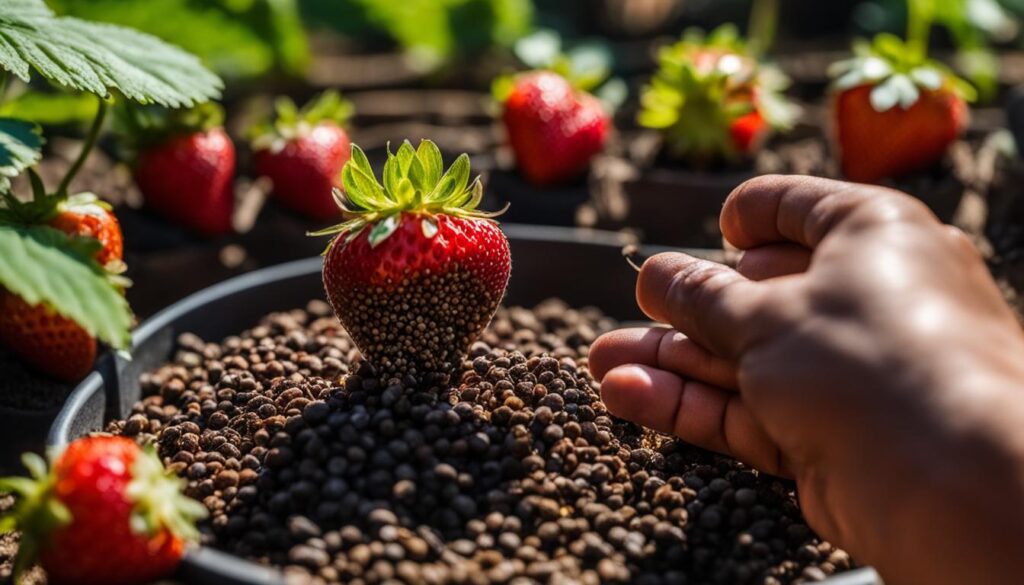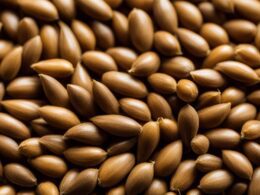Growing strawberries from seed is an exciting and cost-effective way to establish your own strawberry plants. While most people opt for young plants or dormant root clumps, starting from seeds allows you to witness the miraculous growth from tiny leaves to bountiful berry plants. Although it’s important to note that strawberries grown from seed may produce smaller fruit compared to hybrid varieties, the process is relatively simple and can be done indoors before transplanting them to the garden.
When it comes to choosing strawberry seeds, it’s best to go for heirloom varieties or open-pollinated wild alpine strawberries. Seeds from store-bought strawberries may not produce plants true to the parent. You can find high-quality strawberry seeds from reputable sellers online or specialty stores.
Now, let’s talk about timing. To give your strawberry plants a head start, begin planting the seeds indoors about 10-12 weeks before the last spring frost in your area. This will ensure they have enough time to grow strong and enjoy a longer growing season.
Next, let’s dive into the process of germinating and transplanting strawberry seeds. We’ll guide you through each step, from pre-moistening the seed starting mix to transplanting your seedlings to the garden. Follow these instructions, and you’ll soon have your own thriving strawberry patch!
Choosing the Right Seeds and Time to Plant
When it comes to starting your own strawberry plants from seed, selecting the right seeds is crucial for a successful harvest. Opting for heirloom varieties or open-pollinated wild alpine strawberries ensures that the seeds you choose will produce plants true to the parent, unlike store-bought strawberries which are typically hybrids. You can find a wide range of strawberry seeds from reputable seed sellers online or specialty stores. Take your time to research and choose seeds that suit your preferences and growing conditions.
In addition to selecting the right seeds, timing is also an important factor when starting strawberries from seed. To get a head start on the growing season, it’s recommended to plant strawberry seeds indoors approximately 10-12 weeks before the last spring frost in your area. This timing allows the seedlings to establish themselves and develop strong roots, giving them a better chance of thriving when transplanted outdoors. By starting early, you can also enjoy a longer growing season for your strawberries, leading to a more abundant harvest.
Remember, growing strawberries from seed requires patience and attention to detail, but the rewards are well worth it. So, why not embrace the journey and start your strawberry-growing adventure by choosing the perfect seeds and timing your planting just right?
Key Takeaways:
- Opt for heirloom varieties or open-pollinated wild alpine strawberries when choosing strawberry seeds.
- Shop from reputable seed sellers online or specialty stores to ensure seed quality.
- Plant strawberry seeds indoors 10-12 weeks before the last spring frost in your area for a head start on the growing season.
- Give your strawberry seedlings ample time to grow strong before transplanting them outdoors.
Germinating and Transplanting Strawberry Seeds
To successfully grow strawberries from seeds, it’s important to master the process of germination and transplanting. Follow these steps to ensure healthy strawberry seedlings:
1. Germinating Strawberry Seeds
To begin, pre-moisten seed starting mix to create a damp but not soggy environment for your seeds. Fill seed cell trays with the prepared soil, leaving a small gap at the top.
Next, gently place 2-3 strawberry seeds on the surface of each cell, making sure not to bury them. Press the seeds lightly into the soil to establish contact.
Mist the soil with water to provide moisture without causing water pooling. Then, cover the trays with a humidity dome or plastic wrap to create a greenhouse effect that promotes germination.
Place the trays in a warm area, maintaining a consistent temperature of around 70°F (21°C). Keep the soil moist but not overly wet during the germination period.
Strawberry seeds typically take 1-2 weeks to sprout, although germination times can vary. Be patient, and soon you’ll see tiny leaves emerging from the soil.
2. Transplanting Strawberry Seedlings
Once the strawberry seedlings have grown to about 2-3 inches tall and the last spring frosts have passed, it’s time to transplant them into their permanent location. This can either be a prepared garden bed or containers if you’re gardening in limited space.
Before transplanting, prepare the garden bed or containers by loosening the soil and incorporating organic matter for improved drainage and fertility.
To remove the seedlings from the seed cell trays, gently push on the bottom of each cell from below. This will loosen the soil, allowing the seedlings to be easily lifted out.
Place the seedlings in the prepared holes, spacing them about 12-18 inches apart to provide ample room for growth. Make sure the crown of each seedling sits level with the soil surface.
After transplanting, water thoroughly to settle the soil around the roots and remove any air pockets. Maintain regular watering to keep the plants hydrated as they establish themselves in their new home.
It’s essential to harden off the seedlings before planting them permanently outdoors. Gradually expose them to outdoor conditions over the course of a week, starting with a few hours of indirect sunlight and gradually increasing the exposure each day.
By following these steps, you’ll have successfully germinated and transplanted your strawberry seeds, setting the stage for a fruitful harvest in the seasons to come.
Caring for Strawberry Plants and Harvesting
To ensure healthy growth and a bountiful harvest, caring for your strawberry plants is essential. Start by providing regular watering, aiming for about 1 inch of water per week. Adjust this amount based on rainfall, but be cautious not to overwater, as excessive moisture can lead to root rot. It is also important to water at the base of the plants to avoid wetting the foliage, which can increase the risk of diseases.
Strawberries thrive in full sun or partial shade, so choose a location accordingly. They require at least 6 hours of direct sunlight daily to produce the best quality berries. Along with adequate light, regular fertilization will help the plants grow strong and encourage abundant fruit production. Apply a balanced fertilizer according to the recommended dosage on the package, typically every 4-6 weeks throughout the growing season.
One effective way to care for strawberry plants is by mulching with straw. Spread a layer of straw around the plants to suppress weed growth and retain moisture in the soil. This also helps prevent the fruits from coming into direct contact with the ground, reducing the risk of rotting.
Depending on the length of your growing season, strawberries grown from seed may bear fruit in their first year. Harvest the ripe berries by gently plucking them from the plants, being careful not to damage the delicate fruit. After harvest, there are various ways to preserve strawberries for long-term enjoyment. Consider making delicious jams or jellies, freezing them, or drying them for later use in recipes.
With proper care and attention, your strawberry plants can be productive for about 4 years before they start to decline. At that point, it’s a good idea to thin and replace them to maintain a healthy and fruitful strawberry patch.
Can the Method for Starting Strawberry Seeds Be Adapted for Growing Strawberries in Texas?
Yes, the method for starting strawberry seeds can be adapted for growing strawberries in Texas. With proper attention to soil, water, and sunlight, growing strawberries in Texas can be a successful endeavor. Additionally, choosing the right strawberry variety can also make a significant difference in growing strawberries in Texas.










